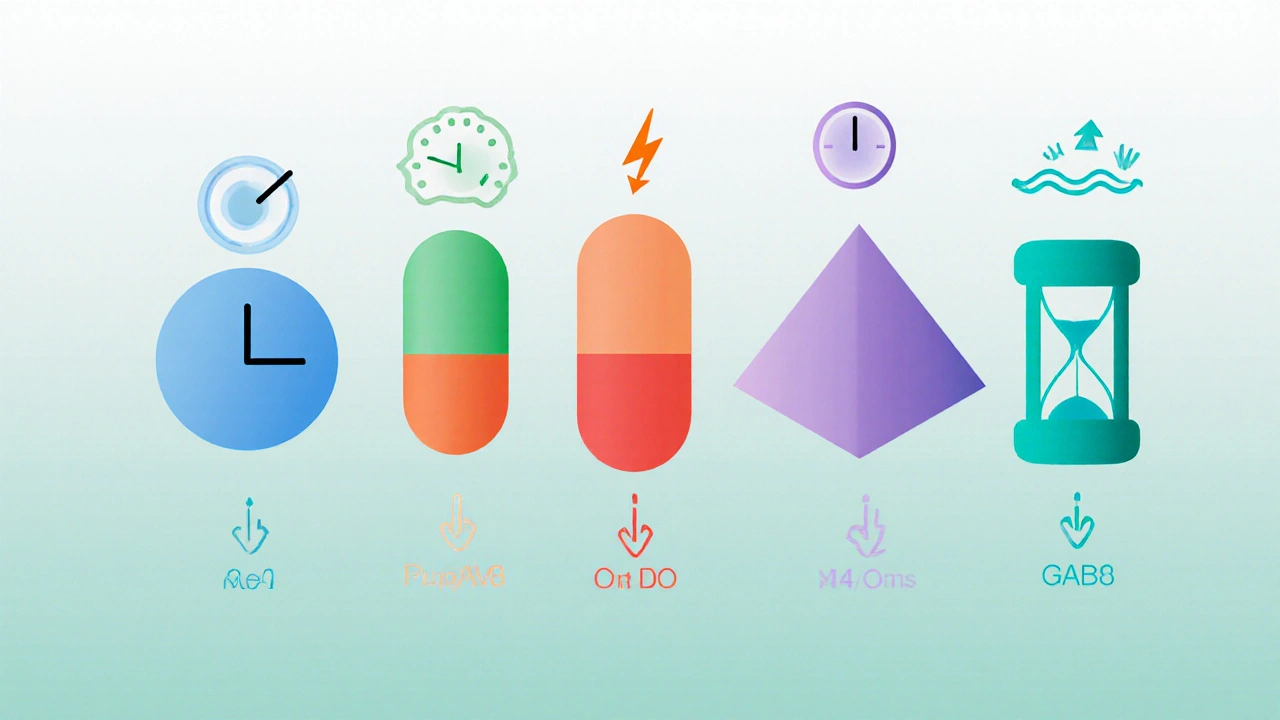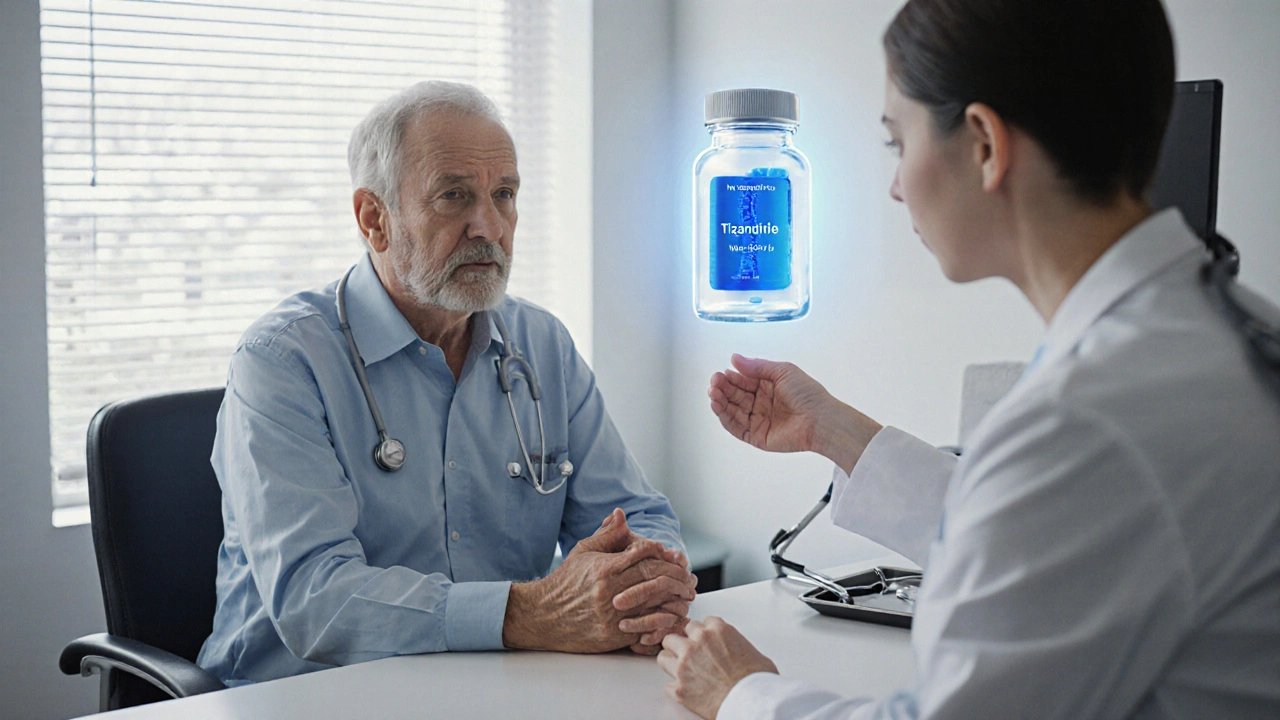Muscle Relaxant Selector Tool
This tool helps compare muscle relaxants based on your specific condition and needs. Select a condition below to see recommended options.
Spasticity
Neurological muscle stiffness
Acute Muscle Strain
Sudden injury or overuse
Anxiety-Related Tension
Stress-induced muscle tightness
Recommended Muscle Relaxants
Select a condition above to see recommendations.
Detailed Comparison
| Drug | Mechanism | Onset (min) | Duration (hrs) | Side Effects |
|---|
Key Factors to Consider
- Condition Type: Spasticity vs. Acute Injury
- Onset Time: Fast vs. Slow relief
- Duration: Short-term vs. Long-term use
- Side Effects: Sedation, Dry Mouth, Hypotension
- Drug Interactions: Check with your doctor
Important Safety Notes
- Always consult your doctor before starting any medication
- Do not combine with CNS depressants
- Monitor for side effects like dizziness or low blood pressure
- Consider liver and kidney function before use
- Be cautious with long-term use due to dependency risks
Key Takeaways
- Tizanidine is a short‑acting α2‑adrenergic agonist that works well for spasticity but can cause dry mouth and low blood pressure.
- When you need a longer‑lasting effect for acute muscle strains, drugs like Cyclobenzaprine or Methocarbamol are often a better fit.
- Baclofen shines for severe spasticity in multiple sclerosis, while Diazepam is useful for anxiety‑related muscle tension but carries sedation risk.
- Choosing the right relaxant depends on the condition, onset speed, duration, and personal tolerance of side effects.
- Always check for drug interactions and kidney‑function limits before starting any muscle relaxant.
What Is Tizanidine?
Tizanidine is a prescription‑only muscle relaxant classified as an α2‑adrenergic agonist. It was first approved in the United States in 1996 and has become a go‑to for clinicians treating spasticity caused by multiple sclerosis, spinal cord injury, or cerebral palsy.
The drug works by reducing the release of excitatory neurotransmitters in the spinal cord, which quiets overactive muscle fibers. Because it targets the central nervous system directly, the dose needed is usually low-commonly 2mg to start, taken up to three times daily. Its short half‑life (about 2‑3hours) means the effect wears off relatively quickly, making it easy to fine‑tune.
Common side effects include dry mouth, drowsiness, and hypotension. Rare but serious concerns are liver enzyme elevation and hallucinations, especially at high doses or in patients with compromised liver function.
How Tizanidine Works: Pharmacology in Plain English
When you take Tizanidine, it binds to α2‑adrenergic receptors on the presynaptic nerve terminals in the spinal cord. This binding blocks the release of substanceP and glutamate-two chemicals that tell muscles to contract. The net result is a calmer, less spastic muscle tone.
The drug is metabolised primarily by the liver enzyme CYP1A2, and about 60% of the dose is excreted unchanged in the urine. Because of the hepatic pathway, strong CYP1A2 inhibitors (like ciprofloxacin or fluvoxamine) can raise Tizanidine levels dramatically, increasing the risk of low blood pressure.
For patients with renal impairment, the dose should be reduced by 50% to avoid accumulation.
Top Alternatives: Quick Snapshot
Below are the most frequently prescribed muscle relaxants that clinicians consider alongside Tizanidine.
- Baclofen - a GABA‑B agonist mainly used for severe spasticity.
- Cyclobenzaprine - a tricyclic‑derived agent effective for acute muscle strains.
- Methocarbamol - a carbamate that provides mild sedation and muscle relaxation.
- Carisoprodol - a centrally acting relaxant with a risk of dependence.
- Diazepam - a benzodiazepine useful when anxiety and muscle tension coexist.

Head‑to‑Head Comparison
| Drug | Mechanism | Typical Indications | Onset (minutes) | Duration (hours) | Common Side Effects | Major Contra‑indications |
|---|---|---|---|---|---|---|
| Tizanidine | α2‑adrenergic agonist | Spasticity (MS, SCI, CP) | 30-60 | 2-3 | Dry mouth, hypotension, drowsiness | Liver disease, severe renal failure |
| Baclofen | GABA‑B receptor agonist | Severe spasticity, spinal cord injury | 60-120 | 4-6 | Weakness, dizziness, constipation | Renal failure (dose adjust), seizure disorder |
| Cyclobenzaprine | Tri‑cyclic antidepressant‑like, blocks NMDA | Acute muscle strain, sprains | 60-90 | 12-24 | Dry mouth, sedation, constipation | Heart disease, recent MI, severe arrhythmia |
| Methocarbamol | Carbamate, depresses CNS activity | Muscle spasms, acute injuries | 30-60 | 6-8 | Drowsiness, headache, nausea | Severe liver disease, hypersensitivity |
| Carisoprodol | Metabolises to meprobamate (GABA‑A modulator) | Short‑term muscle pain, back pain | 30-45 | 6-8 | Drowsiness, dependence, withdrawal | History of substance abuse, severe liver disease |
| Diazepam | Benzodiazepine, enhances GABA‑A | Muscle tension with anxiety, seizure adjunct | 15-30 | 24-48 (long half‑life) | Relaxation, ataxia, respiratory depression | Acute narrow‑angle glaucoma, severe respiratory insufficiency |
How to Pick the Right Muscle Relaxant for You
When the doctor writes a prescription for a muscle relaxant, they’re balancing three core factors:
- Target condition - Is the problem spasticity from a neurological disease, or a sudden strain from sports?
- Desired speed and length of relief - Do you need quick pain relief before a workout, or steady control of chronic tone?
- Side‑effect profile - How tolerant are you of drowsiness, dry mouth, or blood‑pressure changes?
Here’s a quick decision guide:
- If you have chronic spasticity and need tight control, start with Tizanidine or Baclofen. Tizanidine’s short half‑life lets you adjust dose daily.
- For acute muscle strains that improve with rest, Cyclobenzaprine or Methocarbamol provide longer‑lasting relief without the need for multiple daily doses.
- If anxiety fuels the tension, Diazepam can kill two birds with one stone, but only for short‑term use due to dependence risk.
- When you’re worried about sedation because you drive for work, Methocarbamol or low‑dose Baclofen are usually gentler.
Safety Tips and Drug Interactions
All muscle relaxants share a few red flags:
- Never mix with other central‑nervous‑system depressants (opioids, alcohol, antihistamines) unless your doctor explicitly says it’s safe.
- Check kidney and liver function before starting. Tizanidine needs dose cuts for creatinine clearance below 30ml/min, while Baclofen requires adjustment for severe renal disease.
- Pregnancy and breastfeeding: most relaxants are Category C or D. Discuss alternatives like physical therapy if you’re expecting.
- Watch out for CYP interactions. Ciprofloxacin, fluvoxamine, and some antiretrovirals can double Tizanidine levels, leading to dangerous hypotension.
For the elderly, start low and go slow-dose reductions of 25% are common to avoid falls.
Real‑World Scenarios: Who Chooses What?
Case 1 - Multiple Sclerosis Spasticity
Sarah, 42, has relapsing‑remitting MS. Her neurologist tried Baclofen but she felt overly weak. Switching to Tizanidine at 4mg twice daily gave her better tone control with less daytime sedation.
Case 2 - Weekend Warrior Back Pain
Mike, 28, hurt his lower back lifting boxes. He needed fast relief for a night out with friends. A single 10mg dose of Cyclobenzaprine worked for 12 hours, and he avoided the dry‑mouth complaint of Tizanidine.
Case 3 - Anxiety‑Related Neck Tightness
Elena, 35, experiences neck tension during stressful meetings. Her therapist suggested a short course of Diazepam 5mg at bedtime, which eased the muscle clench without interfering with her daytime focus.
Bottom Line
There’s no one‑size‑fits‑all muscle relaxant. Tizanidine shines for quick, titratable control of neurological spasticity, but it can cause low blood pressure and dries out your mouth. Baclofen offers longer action for severe spasticity, Cyclobenzaprine and Methocarbamol are better for short‑term injuries, Carisoprodol carries dependence risk, and Diazepam is the go‑to when anxiety is part of the picture.
Talk to your prescriber about your specific condition, other medications you’re taking, and any kidney or liver concerns. A tailored approach will get you the right balance of relief and safety.

Frequently Asked Questions
Can I take Tizanidine with ibuprofen for muscle pain?
Yes, ibuprofen does not directly affect the metabolism of Tizanidine. However, both drugs can lower blood pressure, so monitor for dizziness, especially when you stand up quickly.
How quickly does Tizanidine start working?
Most patients notice a reduction in spasticity within 30 to 60 minutes after the first dose. The peak effect usually occurs around 1-2hours.
Is Tizanidine safe for people with high blood pressure?
Tizanidine can lower blood pressure, so it’s used cautiously in hypertensive patients. Your doctor may start at a low dose and watch your readings before increasing.
Can I stop Tizanidine abruptly?
Stopping suddenly can cause rebound spasticity or withdrawal symptoms. Taper the dose over several days under medical supervision.
Which muscle relaxant has the lowest risk of drowsiness?
Methocarbamol and low‑dose Baclofen generally cause less sedation compared with Tizanidine, Cyclobenzaprine, or Diazepam.
Are there over‑the‑counter alternatives to Tizanidine?
OTC options like ibuprofen, naproxen, or topical diclofenac can reduce inflammation and pain, but they don’t directly relax spastic muscles the way prescription agents do. Always discuss with a healthcare professional before switching.


Comments (15)
Vishnu Raghunath
Great, another pill that makes you feel like a pretzel.
Aparna Dheep
Reading this feels like a pilgrimage through a pharmacy aisle where every drug pretends to be a saint they’re not the real heroes are the doctors who actually listen the side‑effects list reads like a warning label for a rollercoaster ride if you ignore it you’re flirting with disaster the moral of the story is: respect your body and question every prescription.
Nicole Powell
If you’re looking for a quick fix, Tizanidine is a decent choice but don’t be fooled – the longer‑acting options like Baclofen often outperform it in real‑world spasticity management. Many patients jump on the hype without weighing the sedation trade‑off. The evidence shows that dosage titration is key, and that’s something the average flyer often overlooks.
Ananthu Selvan
This article glosses over the real problem – you keep feeding the pharma machine with endless drug names while ignoring non‑drug therapies. Muscle relaxants are a band‑aid, not a cure, and the side‑effects list reads like a horror story. You’d be better off doing proper stretching and physiotherapy before popping yet another pill.
Nicole Chabot
For anyone juggling a busy schedule, Tizanidine’s short half‑life can be a win because you can adjust doses around work hours and avoid next‑day grogginess. Just remember to take it with food to lessen the dry‑mouth sensation and keep a water bottle handy. It’s also wise to check your blood pressure before the first dose.
Sandra Maurais
From a clinical perspective, Tizanidine’s α2‑adrenergic mechanism offers precise spasticity control, yet clinicians must monitor hepatic function closely 😊. The drug’s rapid onset (30‑60 minutes) is advantageous for acute symptom spikes, but its short duration necessitates multiple daily administrations. Comparative data indicate Baclofen provides more sustained relief for chronic cases, while Cyclobenzaprine excels in post‑injury scenarios. Always evaluate drug‑drug interactions, particularly with CYP1A2 inhibitors, to avoid hypertensive crises. Proper patient education reduces adverse events significantly.
Michelle Adamick
⚡️ Let’s turbo‑charge your rehab plan! Tizanidine rocks the α2‑adrenergic pathway, delivering rapid tone reduction – perfect for high‑intensity spasticity bursts 🚀. Pair it with targeted neuromuscular facilitation and you’ll hyper‑optimize motor unit recruitment. For longer‑lasting coverage, stack with Baclofen’s GABA‑B action, but watch the synergy for hypotension. Remember, dosing titration is the MVP of safety protocols. Keep your physio in the loop and crush those muscle knots! 💪
Edward Glasscote
Just a heads up, Tizanidine can make you a bit sleepy if you take it late.
Gaurav Joshi
Actually the drowsiness is overstated; most patients only notice a mild dip in alertness when they combine it with caffeine.
Jennifer Castaneda
The pharmacokinetic profile of Tizanidine warrants careful dose titration, especially in patients with compromised renal clearance. Studies indicate that a 50 % dose reduction is appropriate when creatinine clearance falls below 30 ml/min. Additionally, co‑administration with potent CYP1A2 inhibitors can elevate plasma concentrations by up to threefold, heightening the risk of hypotensive episodes. Monitoring blood pressure and liver enzymes bi‑weekly during the initiation phase is prudent. These measures collectively mitigate adverse outcomes while preserving therapeutic efficacy.
Annie Eun
Imagine the scene: a tight knot of muscle stubbornly clinging to pain, refusing to release its grip. Tizanidine storms in like a covert operative, whispering to the spinal cord to quiet the over‑excited neurons. The relief arrives in a wave, but the side‑effects linger like shadows at dusk – dry mouth, the occasional dizzy spell, the subtle dip in blood pressure that makes you feel like you’re walking on clouds. Yet, for those battling chronic spasticity, that fleeting calm can be a lifeline, a momentary sigh of freedom in a body that’s constantly screaming. The choice, dear reader, is between fleeting tranquility and the risk of a prolonged battle.
Jay Kay
In practice, I’ve seen patients who start low, 2 mg bedtime, and gradually climb to 8 mg split doses, achieving smooth control without the dramatic drops you described.
Franco WR
When you first consider muscle relaxants, the landscape can feel like a tangled forest of names, mechanisms, and side‑effect warnings, and it’s natural to feel overwhelmed. Tizanidine, with its α2‑adrenergic agonism, offers a rapid onset that can be particularly useful for patients who need swift control over spasticity spikes, especially in conditions like multiple sclerosis or spinal cord injury. However, the short half‑life also means that its effect wanes quickly, often necessitating multiple daily doses to maintain a stable therapeutic window. This dosing frequency can be a double‑edged sword; on one hand, it allows clinicians to fine‑tune the amount based on daily symptom fluctuation, but on the other hand, it introduces a greater risk of missed doses and consequent rebound spasticity. In contrast, medications such as Baclofen provide a longer duration of action, which can simplify the regimen for patients who prefer a once‑ or twice‑daily schedule, though the onset is slower. Cyclobenzaprine, meanwhile, shines in the acute injury setting due to its extended coverage, making it a staple for athletes dealing with sudden muscle strains. Methocarbamol offers a middle ground with moderate onset and duration, and its side‑effect profile leans more toward mild sedation and occasional headaches rather than profound hypotension. When weighing these options, it is essential to incorporate a comprehensive assessment of hepatic and renal function because Tizanidine is predominantly metabolized by CYP1A2 and excreted partially unchanged via the kidneys. If a patient exhibits elevated liver enzymes or reduced creatinine clearance, dose adjustments or alternative agents become necessary to avoid toxic accumulation. Drug‑drug interactions also play a pivotal role; for instance, co‑administering fluvoxamine or ciprofloxacin can dramatically increase Tizanidine plasma levels, precipitating dangerous drops in blood pressure. Beyond the pharmacological considerations, lifestyle factors such as caffeine intake, alcohol consumption, and concurrent use of other central nervous system depressants must be reviewed to mitigate additive sedative effects. Patient education is paramount: informing individuals about the importance of consistent timing, monitoring for signs of hypotension (like dizziness upon standing), and staying hydrated can dramatically improve safety and adherence. Ultimately, the decision matrix resembles a puzzle where each piece – onset speed, duration, side‑effect tolerance, organ function, and personal lifestyle – must align to create a coherent picture of optimal therapy. Engaging the patient in shared decision‑making, providing clear written instructions, and scheduling regular follow‑up appointments to reassess efficacy and tolerability are strategies that enhance outcomes and reduce the likelihood of adverse events. Regularly reviewing the treatment plan ensures that any emerging side‑effects are caught early and addressed promptly. 😊
Rachelle Dodge
The dance between muscle tension and relief mirrors life’s own ebb and flow, each contract a challenge to be soothed. Tizanidine serves as a fleeting whisper, a momentary lull in the storm of spasm. Choose wisely, for every pharmacological lull carries the weight of future reverberations.
Gaurav Joshi
I’ve noticed clinicians often balance the need for rapid spasm control with the risk of hypotension in patients who already have borderline blood pressure. It’s a delicate act, especially when the patient is also on antihypertensives. Practical titration strategies usually involve starting at a low dose and adjusting based on daily blood pressure measurements.